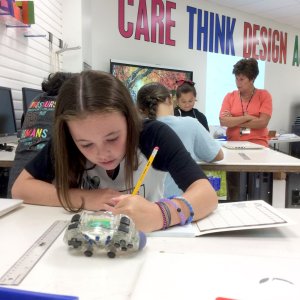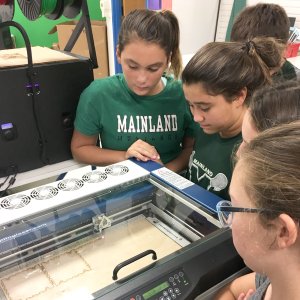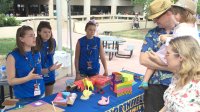An Inside Look at an Award-Winning Maker Program
Making turned New Jersey middle school students into teachers for a weekend—and sent some of them to the White House.
School ended in June 2016 with a crescendo of activity we had worked all year to orchestrate, bringing bigger accomplishments than we’d dreamed of. Our year-end adventure began in Washington, D.C., where my students’ work with design earned us an invitation to the White House for the kickoff of the 2016 National Week of Making. As one of two representatives from New Jersey, I represented not only my students but effectively all K-12 educators in the state for whom making is a way of teaching and learning. Though making is not new—creative individuals in communities and schools everywhere have been doing this work for years—its increasingly high profile certainly is. Making matters. And design thinking matters to makers.

At the beginning of the National Week of Making, I set up our exhibit at the National Maker Faire. Eleven students, including four who had just graduated eighth grade, would spend the weekend explaining how design thinking drove our program’s work and their learning. Kids used student-built prototypes to explain how they employed design thinking to solve problems and make the world a better place.
We set up stations where Faire attendees got to experience prototyping for themselves, tackling design challenges based on the Extraordinaires Design Studio and expertly explained by our kids. The kids’ efforts garnered not one but two awards: Best in Class and Editor’s Choice.
The next day, three teams of seventh-grade students traveled to Jefferson University Hospital in Philadelphia to present their ideas for making hospitals less scary for child patients.
A group of nearly 70 people, including relatives, friends, hospital professionals, fellow educators, and members of the press, watched the student teams present their ideas and recommendations. It was a very good day. And it was just the beginning, as these students would work with JeffDESIGN over the summer to learn valuable lessons about what it takes to get an idea from concept to production in the real world.
In the span of four days, our kids met and conversed with hundreds of people about their accomplishments as designers, experiencing a level of personal and professional validation that many adults rarely get to enjoy. It was a fantastic end to a fantastic year.
So how is our program growing, changing, and adapting this year?
Initiative One: The EPICS Curriculum and Processes
We have adopted the free and fabulous EPICS—Engineering Projects In Community Service—as the heart and soul of our program this year. I attended a summer training at Purdue University; it was exhaustive and a great investment. EPICS is all about documenting design thinking processes. To that end, they have assembled a massive library of resources, including fully editable and customizable documents teachers can use to plan projects.
I love that the EPICS framework is just that—a framework. It provides a flexible structure I can modify as necessary to suit our processes and needs. As of this writing, we are still deep in that customization process; I expect that it will take most of this year to finalize. When we are done, we’ll have a powerful, document-driven, human-centered methodology to guide our work in design.
Initiative Two: Bringing the Outside In

Last year, students connected with professional designer Meghan Holliday, who spoke about her life and work as a designer. This year, we’ve got Andrew Coy, senior advisor for making in the White House Office of Science and Technology Policy, sharing why making is critical in schools today; Alixandra Klein, a Vermont-based entrepreneur who makes jewelry using a laser cutter and upcycled materials, talking about the importance of art and creativity; and Dr. Jorge Valdes of the U.S. Patent and Trademark Office (and also a high school science teacher here in New Jersey) discussing intellectual property, patents, and the inventor’s mindset. And all of this is just for Design Experience One.
Initiative Three: Changes to the Instructional Environment
We were fortunate to acquire an Epilog laser engraver last summer. It has quickly proven to be a game-changer for our program, capturing imaginations and literally igniting creativity like no other tool previously. Our new “soft seating” area includes a SMART Board 6000 interactive display, an Ikea coffee table (donated), an Xbox 360 (also donated), and a leather couch I found for sale on Facebook for $75. The combination of these items has made a terrific small group instructional area, while providing kids who have lunch in my room a chance to enjoy some gaming.
Final Thoughts
The new school year has gotten off to a good start. We’re creating an entirely new understanding of design thinking in Digital Shop, an amalgam of our shared past experiences and the practices of some of the world’s best design thinking practitioners. It’s ridiculously hard work, alternatively frustrating and exhilarating, but totally worth it.
